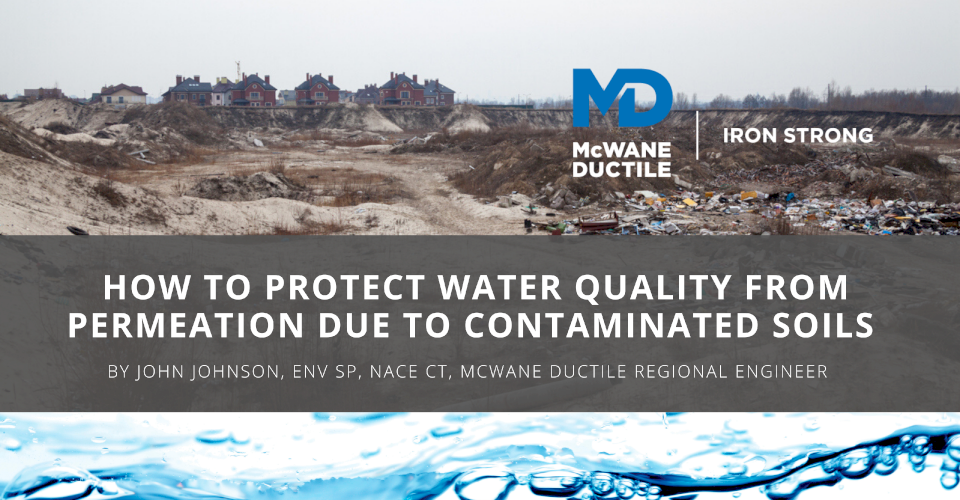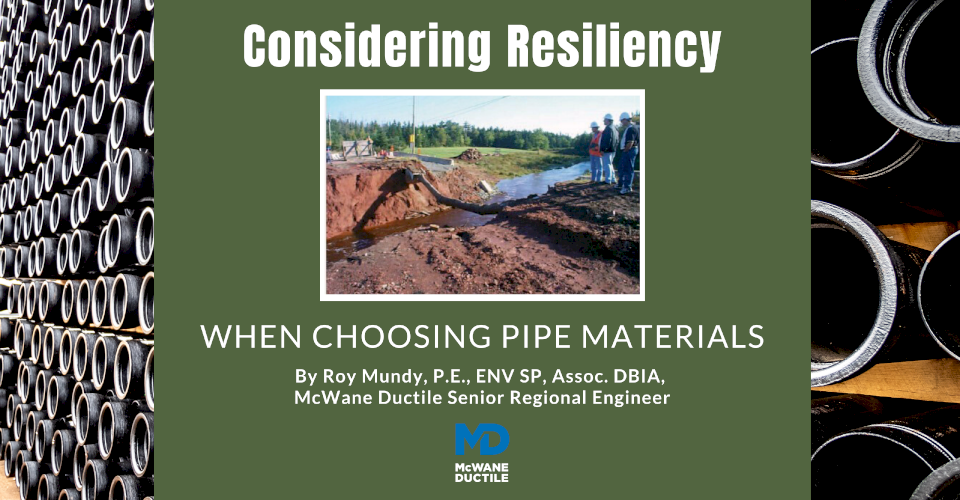-
What is the Purpose of Calcium Hypochlorite Granules?
03/20/2021 In Environmental & Safety TechnicalCalcium hypochlorite is an inorganic compound added in granular or tablet form added to water to kill germs that can make people sick. When used correctly, this compound destroys germs that can cause numerous health problems. ANSI/AWWA standard C651-14 incorporates essential procedures and requirements for the disinfection of new potable water mains. In this blog, we’ll cover why, when, and how it’s used in the waterworks industry.
-
Why PVC is Inadequate for Fire Protection in Distribution Systems
10/31/2020 In Environmental & Safety product TechnicalToday, most water systems serve the public in two ways: by providing potable drinking water and enabling fire protection for the community. Fire protection provides more than just the obvious public safety benefits. It also enhances community property values and provides residents with lower home and property insurance rates.
-
Do You Have an Iron Deficiency? Considering Health Effects in Pipe Material Selection
08/13/2020 In Environmental & Safety ProductsWe in the United States are most fortunate, for the most part, to have access to safe, clean drinking water. Even when traveling, we are not hesitant to draw water from a hotel faucet to brush our teeth or even fill a glass to drink. This privilege is no accident.
-
Updates to Envision® and How Ductile Iron Excels in The New Rating System
07/23/2020 In Environmental & Safety Installation ProductsThis Blog Reflects Significant Updates for Envision Manual V3. As we know, America's infrastructure is in crisis! According to the American Society of Civil Engineers, the estimated investment needed is $1 Trillion over the next 25 years for underground water infrastructure. This investment, as well as the ever-increasing cost of electricity, limited water supply, ever-decreasing natural resources, and environmental concerns, are driving the need for change. Change on how infrastructure is designed and constructed – utilizing more sustainable design and construction practices. ENVISION is designed to provide guidelines for these changes to North American infrastructure. In short, it is a rating system approach very similar to LEED Building Certification; however, with the focus on infrastructure.
Envision not only asks, ‘Are we doing the project right?’ but also, ‘Are we doing the right project?’
-
How to Protect Water Quality from Permeation Due to Contaminated Soils
07/17/2020 In Environmental & Safety Products TechnicalFor buried pipelines, several soil conditions can adversely affect water quality through permeation. As a waterworks professional, you most likely will ask, “Where and when might these harmful conditions be present, or even potentially develop, and what solution is available to best protect my water system from this issue? We will examine several common risks in this #IronStrong Blog and discuss protective measures that can be employed. These risks can include contaminated soils from areas in or near older landfills, industrial sites, and abandoned or leaking fuel tanks, among others.
-
Considering Resiliency When Choosing Pipe Materials
07/01/2020 In Environmental & Safety InstallationIn this third installment about Sustainability and Resiliency for our Iron Strong Blog, we are focusing on the resiliency of pipe and pipelines as a result of natural disasters such as storms, floods, and wildfires. While earthquakes and seismic events also need to be considered, much has been written on those aspects and we will discuss them in our next installment. Resiliency means many different things to many different people, and its definition is often a matter of perspective and need. Put simply, resiliency is the ability to survive, resist, or recover from damage due to some external hazard.
-
Got Certification? Fabricated Ductile Iron Pipe and NSF/ANSI 61
06/10/2020 In Environmental & Safety TechnicalGot Certification? Does your fabricated Ductile iron pipe meet the current ANSI/AWWA C115 / A21.15-11 Standard for fabricated pipe?
Products intended for contact with potable water shall be certified to the requirements of NSF/ANSI 61. The certification shall be accomplished by a certification organization accredited by the American National Standards Institute (ANSI) AWWA Standard, ANSI/AWWA C115/A21.15-11 Section 4.1.2. This standard includes water service pipe, water distribution lines, water treatment plants (WTP), and commercial and industrial services lines.
-
Sustainability & Resiliency – The Impact of Recycling and Using Recycled Products
06/05/2020 In Environmental & Safety ProductsIn this second installment of our Iron Strong Blog on Sustainability and Resiliency, we will focus on recycling and the recyclability of various pipe materials. As you may know, Ductile iron pipe is made from recycled iron and steel scrap, making it not only a recycled product but a recyclable product.
Okay, since that fact has been stated, why read further? Well, besides being the only primary full-size-range piping product made from recycled material, you should know why this is important to you, me, and everyone else. We will look at the impact of recycling on cities and towns as well as countries and the planet.
-
How Does Ductile Iron Pipe Answer the Challenge of Sustainability and Resiliency?
05/27/2020 In Environmental & Safety ProductsSustainability and Resiliency are today's buzzwords, especially concerning water and wastewater systems, but what does this really mean to you, the designer, manager and/or operator? Utility people today are bombarded with the answer to this question, and we believe that there is no one answer because every system is unique and experiences different priorities and different challenges.
-
Should A Water Utility Manager Let System Infrastructure Dictate Water Treatment Methodology?
05/22/2020 In Environmental & SafetyProviding safe, clean water to customers of a water utility is unquestionably JOB ONE. Meeting this goal has always been a formidable challenge in many ways. Source water quality can change dramatically due to weather factors and other phenomena. Additionally, increasing drinking water standards throughout the years evidencing higher detection technology and more sophisticated medical research regarding the health effects of contaminants has required water systems in some cases to change treatment methodologies dramatically.
Should the pipeline material placed in a drinking water system in any way limit decisions of today or in the future regarding the water treatment methodology chosen to best provide safe, clean water to customers? I THINK NOT!
Latest Posts
- Developing an Asset Management Plan for Your Future Utility or Engineering Organization 12/04/2025 In Comparisons Industry
- Can Joining Water Works Industry Organizations Help You Grow Professionally? 10/21/2025 In Careers WaterWorks
- How Does Ductile Iron Pipe Provide Proven Resilience to Seismic Events? 09/04/2025 In Products Resiliency Technical
- How to Secure Green Reserve Sustainability Incentives Using State Revolving Funding & Ductile Iron Pipe 07/29/2025 In Energy Products Technical















